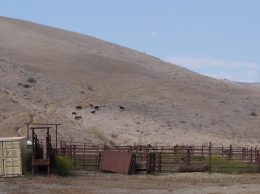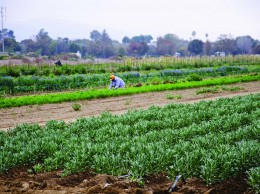The drought plaguing the Tri-Counties and the rest of the state has the agriculture industry on red alert.
With 2014 forecast to be the driest year in California history, Gov. Jerry Brown has declared a drought emergency in the state, and the U.S. Department of Agriculture has designated 27 counties in California as primary natural disaster areas, including the tri-county region.
Brown’s emergency declaration on Jan. 17 directs state officials to assist farmers and communities that are economically impacted by dry conditions and calls on all Californians to reduce their water usage by 20 percent. The USDA designation announced Jan. 15 allows farmers and ranchers in affected areas to qualify for natural disaster assistance.
“The drought emergency declaration is a welcome development for Central Coast farmers and communities,” U.S. Rep. Lois Capps of Santa Barbara said in an emailed statement to the Business Times. “It will help free up valuable resources and empower state and local officials to respond to and prepare for the impacts of these record dry conditions.”
Local rainfall totals are dismal, with Santa Barbara County measuring 16 percent of normal for the current water year, which started Sept. 1. San Luis Obispo County is slightly worse off with 15 percent of normal, and Ventura County is reporting a meager 13 percent. Agricultural commodities in the three counties reached a combined value of $4.1 billion in 2012, the last year for which figures are available.
Cattle and crop farmers beg for rain
“We are in a very critical situation,” said Royce Larsen, area natural resource watershed adviser for the University of California Cooperative Extension in Templeton, citing three years of drought.
Larsen, who works with rangeland, and other industry experts noted the extreme hardship on cattle farmers in the region. The continuing dry conditions have had a compounding effect, with no old feed left over from last year and not enough rain this year to enable germination for new feed. “In essence, there’s nothing out there for cattle to eat,” Larsen told the Business Times.
San Luis Obispo and Santa Barbara counties saw a loss of about 90 percent of their grasses last year, he said, and an inch of steady rain is needed to germinate this year’s seeds. So far, Larsen said, most areas haven’t even seen half an inch of rainfall.
The lack of natural feed is forcing producers either to buy supplemental feed, which is very expensive, or to sell off their herds — with some getting rid of as much as half of their livestock, Larsen said.
“If they have to sell off, it will take them a number of years to rebound, to rebuild to sustainable levels,” Brenda Ouwerkerk, SLO County’s assistant agricultural commissioner, told the Business Times.
Turning to farming, she said the dearth of rain could delay planting or hinder the growth of crops that were planted early. “They may have germinated, but unless they get moisture between now and March, they’re not going to grow,” Ouwerkerk said. “So even things that were already planted are going to be affected.” Farmers, who depend on long-term planning, will have to decide whether to make the investment to plant when there may not be rain, she said.
Out in the vineyards, Larsen said salts are building up in the soil because there has been no precipitation to flush them out. The same is true for other row crops. Vintners and farmers are instead having to use irrigation water to leach the salts out of the soil.
“Everyone is very aware of overdraft,” Ouwerkerk said. “And if the groundwater isn’t being recharged, everyone is going to be looking for irrigation water.”
Stalled farm bill hampers relief
Gov. Brown’s drought emergency declaration is intended to provide some relief — at least financially. Ranchers and farmers are eligible for low-interest emergency loans, in addition to other assistance provided through the USDA’s “disaster area” designation. “When the federal government and the state of California agree that there’s a drought declaration, then that opens up the availability of some federal programs,” said Debbie Trupe, agricultural compliance coordinator for Santa Barbara County, which has proclaimed its own local drought emergency.
But USDA aid through channels such as the Noninsured Crop Assistance Program and the Emergency Livestock Assistance Program is dictated by the federal farm bill, Larsen said. The long overdue bill is currently stalled in Congress, which is set to return from recess on Jan. 27, leaving just a few days to pass legislation before February.
U.S. Rep. Julia Brownley of Westlake Village said she is working with her colleagues in Congress to pass the next farm bill. “The farm bill will help promote conservation, provide producers with risk management options that offer protection when they suffer significant losses, and improve upon the crop insurance program,” she said in an emailed statement to the Business Times.
In the meantime, the agricultural community is looking to the heavens for the real relief.






 Print
Print Email
Email


















Watch this short news story about technology that purifies and reclaims 100% of all your household/business/facilities’ polluted water/sewage discharge.
http://youtu.be/Hydg6cvls88 Technology that saves millions of gallons of water every single day and is federally mandated yet the county of Santa Barbara & San Luis Obispo along with Jerry Brown have swept it under the rug causing our drinking water to be polluted with toxins and wasted while we are in the worse water shortage in history!